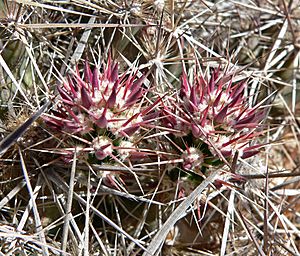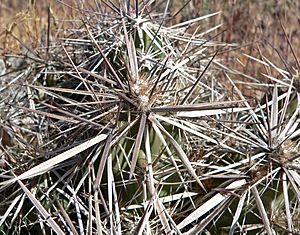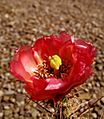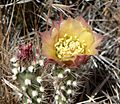Club cholla facts for kids
Quick facts for kids Club cholla |
|
|---|---|
 |
|
| Grusonia parishiorum | |
| Scientific classification |
|
| Kingdom: | Plantae |
| Clade: | Tracheophytes |
| Clade: | Angiosperms |
| Clade: | Eudicots |
| Order: | Caryophyllales |
| Family: | Cactaceae |
| Subfamily: | Opuntioideae |
| Tribe: | Cylindropuntieae |
| Genus: | Grusonia Rchb.f. ex Britton & Rose |
| Type species | |
| Grusonia bradtiana |
|
| Species | |
|
See list |
|
| Synonyms | |
|
|
Grusonia is a type of cactus that grows in the North American Deserts. You can find these unique plants in the Southwest United States and northern Mexico, including Baja California.
Scientists sometimes debate the exact boundaries of this group of cacti. For a while, some thought it was part of another cactus group called Cylindropuntia. Another name you might hear for these cacti is Corynopuntia. People also call them club chollas or "perritos" in Mexico. Today, most scientists agree that Corynopuntia is actually the same as Grusonia.
Contents
What's in a Name?
The name Corynopuntia comes from a Greek word, coryne. This word means 'club'. So, the name refers to the club-shaped parts of these cacti. That's why they are often called "club chollas"!
What Do They Look Like?
These special cacti usually grow in low, cushion-like shapes. Their stems are made of oval or slightly club-shaped parts. These parts can be from 1 to 25 centimeters (about 0.4 to 10 inches) long. They have bumps but no ribs, and their surface is smooth.
Be careful around them! Their spines are very strong and prickly. They have tiny teeth along their edges, which makes them quite dangerous. The tips of the spines are covered by a thin layer.
Most Grusonia cacti have yellow flowers. But some kinds can have pink or even deep magenta (purplish-red) flowers. The fruit starts out fleshy but soon dries up. It's usually yellow to brownish and can sometimes smell bad. The fruit is often covered in tiny, barbed bristles called glochids, and also spines. Inside, the seeds are yellowish-white to brownish and can be round or flat.
Many types of club chollas look very similar to each other. For a long time, scientists didn't study them much because of this. However, new research is helping us learn more about these plants. It turns out there are many types of Grusonia that scientists haven't even named yet! Even though they look alike, different kinds of club chollas rarely mix and create new types when they grow together in the wild.
How Scientists Classify Them
The group Corynopuntia was first named in 1935. At that time, it was separated from the larger Opuntia group. Later, in 1999, a scientist named Anderson included Corynopuntia within a broader group called Grusonia.
Scientists have used different methods to study these plants. They looked at their DNA and even the tiny details of their seeds. These studies suggested that Corynopuntia should be its own separate group again. This idea was accepted by a group of cactus experts in 2006.
However, more recent DNA studies in 2016 showed something different. They found that if Corynopuntia and Grusonia were kept separate, they didn't fit neatly into the cactus family tree. Because of this, most scientists now agree that Corynopuntia should be combined with Grusonia. This means they are all part of the same Grusonia group.
Where Do They Grow?
Club chollas are native to the southwestern parts of the United States. You can find them in California, Arizona, Nevada, New Mexico, and Texas. They also grow in northern Mexico. This includes states like Baja California, Sonora, Chihuahua, and many others. They can be found from about 60 meters (200 feet) up to 2000 meters (6,500 feet) above sea level.
How They Live in Nature
Club chollas usually grow in very dry areas. They prefer flat lands or gentle slopes. They need lots of sunlight, but sometimes you can find them under small bushes. They can grow in sandy, loamy, or gravelly soil, depending on the specific type of cactus.
One interesting thing about these cacti is how they spread. The stem segments of many species break off easily if something touches them. This is a very important way for these cacti to reproduce. Their finely toothed spines can stick to animal skin or fur. Then, the animal can carry the segment for miles! The barbed spines can stay stuck in the skin, which can be uncomfortable or even cause small injuries to the animal.
Images for kids
See also
 In Spanish: Grusonia para niños
In Spanish: Grusonia para niños

















